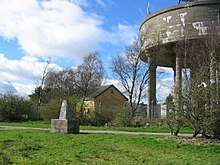Carrickstone
Carrickstone is an area of Cumbernauld, Scotland. It is on the north of the M80 and west of Cumbernauld Town Centre. The area it now occupies used to be covered by Carrickstone farm with the 25 inch Ordnance Survey map showing it between an ancient "standing stone"[1] and The Village.[2]



Toponymy
The historical etymology of Carrickstone's name is uncertain although it is now undoubtedly tied to the Roman altar.[3]
History
Carrickstone is named after the only Roman altar still in the open air in Scotland.[4][5] John Watson in the New Statistical Account of Scotland described the stone long before the modern settlement took shape.[6] The stone has also been linked with Robert Bruce, being the place where he reportedly set up his standard on his way to Bannockburn.[7] There is a some evidence that coffins were laid on top of the stone on their way to the cemetery in Kirkintilloch[8] and that the stone has been somewhat worn away.[9] Several old documents show Carrickstone including maps by Charles Ross,[10] and William Roy.[11]
References
- Historic Environment Scotland. "Carrickstone (45818)". Canmore. Retrieved 2009-04-02.
- "OS 25 inch Map 1892-1949". zoomable map with Bing transparency overlay. National Library of Scotland. Retrieved 10 October 2017.
- Drummond, Peter, John (2014). An analysis of toponyms and toponymic patterns in eight parishes of the upper Kelvin basin (PDF). Glasgow: Glasgow University. p. 226. Retrieved 3 July 2017.
- "Roman altar, near (sic) Cumbernauld". Retrieved 21 October 2017.
- "HAZARD INFORMATION FOR TEACHERS CARRICK STONE: ALTAR" (PDF). Frontiers of the Roman Empire. Retrieved 13 October 2017.
- Watson, John (1845). The new statistical account of Scotland (Vol 8 ed.). Edinburgh and London: W. Blackwood and Sons. pp. 141–142. Retrieved 14 February 2018.
- Grant, Clare (2 April 2003). "Saga of the Carrick Stone". Cumbernauld News. Retrieved 13 October 2017.
- Watson, Thomas (1894). Kirkintilloch, town and parish. Glasgow: J. Smith. p. 121. Retrieved 13 October 2017.
- Donelly, W. A. (1892). Proceedings of the Society of Antiquaries of Scotland. Edinburgh: Neill & Co. pp. 228–230. Retrieved 13 October 2017.
- "Ross' map with Carikston". NLS. Retrieved 27 January 2018.
- "Roy's map of the Lowlands". NLS. Retrieved 27 January 2018.
.jpg)